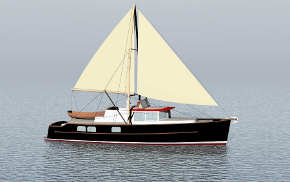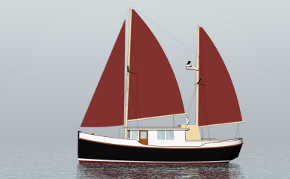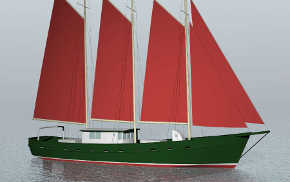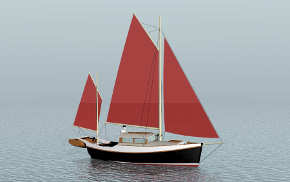Kedging, Another Lost Art.
Summer has flashed by once again with one quarter of the anticipated projects actually completed. We did have a fair amount of painting weather this year and I got almost the entire outside of the boat painted. A slow leak gradually worsened causing great worry until I bit the bullet and we kedged across the harbour and dried out for a tide. Luckily it was a daytime low almost big enough to completely dry us out. The culprit was one butt down low in the planking. In this double-sawn frame hull there are no butt-blocks, the butts are all on frames and thus no inside access. Another problem is our full interior ceiling so if there’s a leak you can’t see it……And then once you find where the water is coming from inside you need to guess again outside……..Anyway we ended up reefing and caulking two butts in the correct general vicinity, right underneath the outside cooling pipes of course….student built boats! The one butt had nothing in it but a bit of mud….. We just have one piling to use as support here but she stands up (a bit bow down due to rake on the keel bottom) rock solid in the mud. So it’s nice to go into winter with a non-leaking hull. Of course the rains came last week and water poured in from the top, but things will close up again soon. Had a fire (in the stove) all night last night, first time for that this year…..
After writing the above someone asked, “Kedging, seriously?” Yes, kedging seriously. We are not just maintaining and restoring an old boat, we use the skills, equipment, and tools appropriate to the jobs undertaken. These skills will not be passed on by pictures in a book or a drawing in a museum; they must be used and seen to work. I would guess that for the 40 boats in our bay (weekenders and charter boats, all plastic I might add) it’s the first time they ever saw anyone kedge anywhere.
Technically the kedge is just a small anchor carried for the purpose of kedging. Cruising boats no longer carry such equipment but 40 years ago it was considered essential.
It’s a lost art, seemingly relegated to use after you end up aground. In that case it is very useful, but just moving the boat without an engine kedging comes into its own. I recall how impressed the boys were when I showed them kedging the first time. They found moving the 40’ engineless cutter Cresset a breeze with two 15lb Bruce anchors on light line…..just like threading a needle with all the tourist boats at anchor and of course the tide running…..but very satisfying to inch silently past them at dawn…..Hours later they’re up in the cockpit rubbing their eyes….”How did that big black boat get way up there?” It takes only a moderate pull to move a large boat very slowly, a winch is too slow and not at all necessary unless you are aground or in a gale needing to go upwind.
The momentum is considerable but no…….to get the kedges in the right place we use the longboat. Work up-tide as much as possible so you can always just stop. Two anchors, a 66lb Bruce and a 45lb CQR, on 300′ and 200′ of line, no chain. Two men, one on deck and one in the longboat, as you come up to one anchor and hoist it the other is already down out ahead. We only have about 30′ of water here at high tide so it’s pretty easy….but does wear out the old guy…me…
Well…..I was up every night for a week worrying about the leak getting worse….after I’d had enough of that…..The night before we hauled the main anchor and chain (110lb Northill, by hand) and moved to a mooring so we were ready for the morning. At 5:00am I ran out the first anchor, probably a dozen moves to get our longest line on the piling. Warp the boat in against the piling and re-set the kedges forward and aft to hold us in place. Then we had breakfast as the tide started to drop, then started work and finished about 3:00pm for a bit of rest (I think I had a nap) before kedging back out about 8:00 and re-anchoring just at dark(high-summer)……I was exhausted the next day. The boys were great……I didn’t take a single picture…..
-
External Links
- Sorry, no links have been posted




